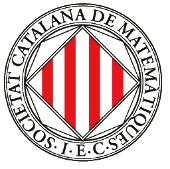Tibor Antal (The University of Edinburgh)
Title: Multitype branching processes: from bacteria to cancer.
Abstract: We’ll review recent developments in the theory of two type birth-death branching processes. These studies were pioneered by Salvador Luria and Max Delbruck in 1943 to model genetic mutations arising in bacterial populations. More recent applications include the development of resistance to chemotherapy of cancer.
Marta Casanellas (Universitat Politècnica de Catalunya)
Title: Algebraic tools in the evolution of species.
Abstract: Many statistical models of nucleotide substitution can be viewed as algebraic varieties. As a consequence, tools from algebra can add information on the phylogenetic reconstruction problem. We shall present methods of phylogenetic inference based on algebraic tools and, by comparison to other exiting methods, we shall discuss what are the advantages and disadvantages of these new methods.
Andrei Korobeinikov (Centre de Recerca Matemàtica)
Title: Mathematics of viral evolution.
Abstract: Viral evolution is probably the most significant single factor accountable for emergence of new pathogens and drug-resistant strains and preventing a development of effective drugs and vaccines. Moreover, it is believed that the dynamics of HIV is also mostly determined by the ability of HIV to evolve. The most natural question arises about the driving force for this evolution. Other questions are about the role of immune pressure in this natural selection and about the links between evolution and the development of AIDS.
Viruses, and RNA viruses in particular, rapidly evolve, and HIV is known to be one of the fastest evolving human viruses. It is now commonly accepted that viral evolution is the cause of the intriguing dynamics exhibited during HIV infections and the ultimate success of the virus in its struggle with the immune system. An objective of this talk is to introduce a simple mathematical model of the within-host viral dynamics which incorporates random mutations. This model assumes a continuous distribution of viral strains in a one-dimensional variant space where random mutations are modelled by diffusion. Numerical simulations show that random mutations combined with competition result in evolution towards higher Darwinian fitness: a stable traveling wave of evolution, moving towards higher levels of fitness, is formed in the phenotype space.
Nikola Popovic (The University of Edinburgh)
Title: A geometric analysis of fast-slow models for stochastic gene expression.
Abstract: Stochastic models for gene expression frequently exhibit dynamics on different time-scales. One potential scale separation is due to significant differences in the lifetimes of mRNA and the protein it synthesises, which allows for the application of perturbation techniques.
Here, we develop a dynamical systems framework for the analysis of a family of “fast-slow” models for gene expression that is based on geometric singular perturbation theory. We illustrate our approach by giving a complete characterisation of a standard two-stage model which assumes transcription, translation, and degradation to be first-order reactions. In particular, we develop a systematic expansion procedure for the resulting propagator probabilities that can in principle be taken to any order in the perturbation parameter.
Finally, we verify our asymptotics by numerical simulation, and we explore its practical applicability, as well as the effects of a variation in the system parameters and the scale separation.
Mariya Ptashnyk (University of Dundee)
Title: Multiscale analysis of elastic-viscoleastic model for plant cell wall biomechanics.
Abstract: Plant cell walls, consisting of cellulose microfibrils and wall matrix, composed of proteins, water and polysaccharides (hemicelluloses and pectins), have complex dynamical mechanical behaviour. This is necessitated by the fact that they must be strong to support a high internal (turgor) pressure, but at the right moment be able to yield to allow for cell growth. It was observed that changes in cell wall elasticity are strongly correlated with changes in the pectin matrix chemistry. In this talk I will present a microscopic model for plant cell wall biomechanics that takes into account both the microstructure coming from the cellulose microfibrils and the chemical reactions between the cell wall’s constituents. The mathematical model constitutes a strongly coupled system of elastic-viscoelastic equations for deformations of plant cell walls and non-linear reaction-diffusion equations, describing chemical processes in cell wall matrix. To analyse the macroscopic behaviour of plant cell walls, as well as for effective numerical simulations, the macroscopic model for cell wall biomechanics is rigorously derived by applying homogenisation techniques.
Jordi Ripoll (Universitat de Girona)
Title: Impact of non-linear diffusion on epidemic outbreaks in heterogeneous metapopulations.
Abstract: We investigate the role of migration/diffusion patterns on the spread of epidemics in complex networks. We enhance the SIS-diffusion model on metapopulations to a non-linear diffusion. Specifically, individuals move randomly over the network but at a rate depending on the population of the departure patch. The migration-driven equilibrium is described by quantifying the total population living in heavily/lightly populated areas and the short-term outbreak situation is given by the linearisation of the system around the equilibrium. Our analytical approach reveals that strengthening the movement of individuals from populous areas to sparse ones contains the epidemic spreading. Moreover, depending on the exponent of the non-linear diffusion rate, epidemic outbreaks do not always occur in the most populated areas as one may expect.

